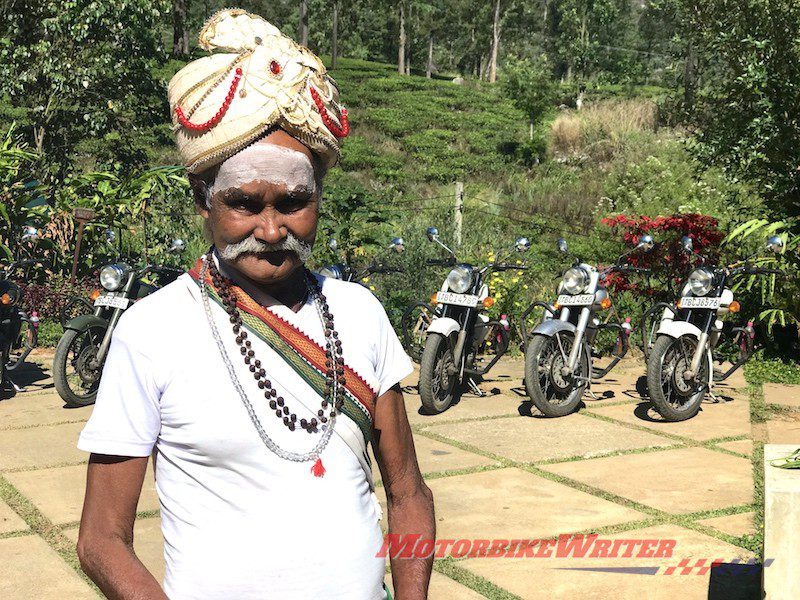After the recent bombing tragedy in Sri Lanka, security has been stepped up and it’s now deemed safe to ride this gem of a destination for motorcyclists. Who better to give us a guide to riding in Sri Lanka than Rohan Sourjah who has written a book about it called “Motorcycling Adventures in Sri Lanka” and recently returned from a ride around the country. Here’s his story:

Background
The island of Sri Lanka is shaped like a teardrop and the people in that nation have shed many tears over the years. There was hope in their hearts because the three decades civil war had ended almost 10 years previously.
But on Easter Sunday this year, fundamentalist suicide bombers blew themselves up in three churches and three luxury hotels, killing more than 250 people and injuring about 500, including many innocent children.
The aftermath has been devastating as tourists stopped arriving. Tourism is the livelihood of more than a million people who suddenly had no way of earning an income and feeding their families. In just a matter of seconds, their lives had been devastated. Almost five months later, their situation remains dire because only a few tourists are visiting the island.
I grew up in Sri Lanka and some of my most wonderful memories are of riding a small Yamaha YB90 two-stroke motorcycle to many parts of the island with school friends on their own machines.
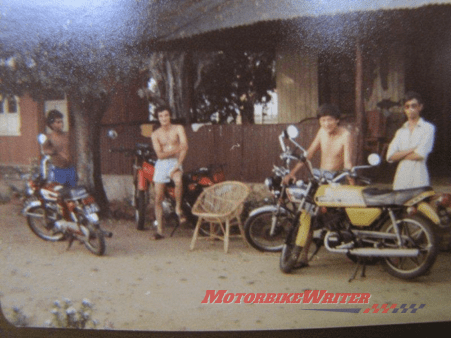
Fast forward to 2014 and I bought a Royal Enfield 350cc “Classic” bike in Sri Lanka. My plan was to ride around the island and once again visit the beaches, mountains, historical sites and wildlife sanctuaries as well as experience the different cultures, religions and diverse landscapes that the “Pearl of the Indian Ocean” offers. This took four years to complete and I published a book about those travels in June this year titled “Motorcycling Adventures in Sri Lanka.”
One of the reasons for publishing this book is to attract motorcyclists to visit Sri Lanka because it does offer some wonderful riding experiences in an exotic and tropical land. And I hope readers of this article would consider travelling to Sri Lanka, whether to ride a motorcycle or travel in a vehicle, to help the people of the island. Whatever money you spend over there would benefit families who are suffering and more importantly show terrorists that their senseless and inhumane actions don’t scare us motorcyclists.
Ride for Sri Lanka
The Easter Sunday bombings took place after I had booked my airline tickets for the launch of my book. I didn’t change my travel plans, but I was very shocked when I landed in the island because hotels and tourist businesses were virtually empty.
It was during this time that I hatched a plan with some of my school friends about planning a “Ride for Sri Lanka” to show solidarity with the people and encourage tourists, particularly motorcyclists, to visit the island. The plan was to entice journalists of motorcycle magazines from around the world to come to Sri Lanka, ride on a planned tour, and then go back and write about their experiences. However, the planning for that event takes months and that ride is planned for around February 2020.
(Motorbike Writer rode around the island with Extreme Bike Tours in February 2018.)
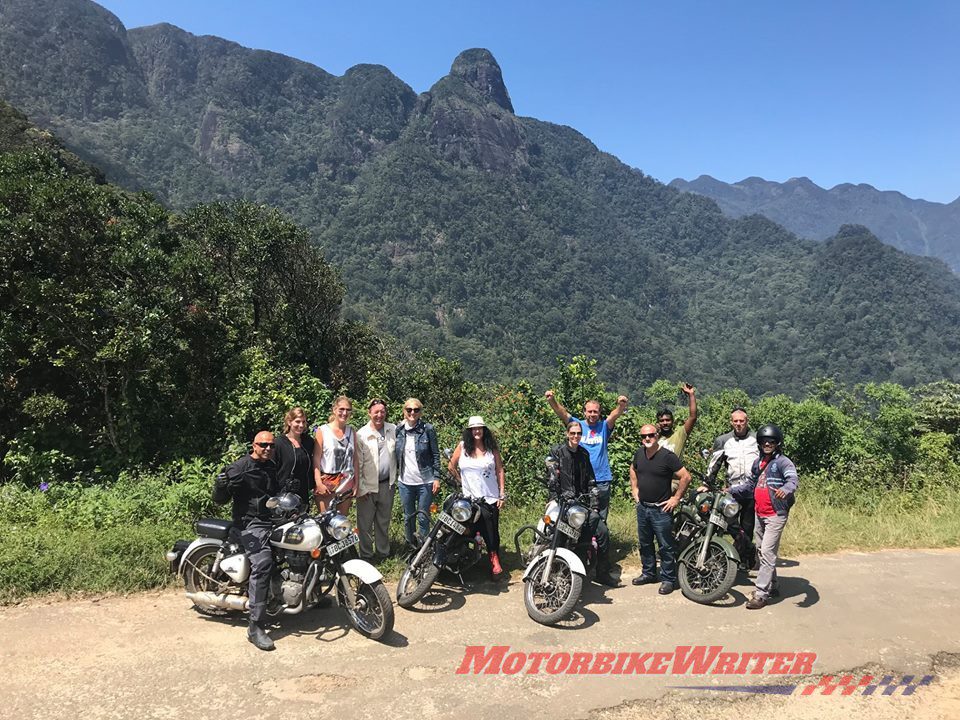
Riding for Sri Lanka (23-28 August 2019)
I was acutely aware that the Sri Lankan people urgently needed to entice tourists back to the island, and that they wanted those tourists NOW! With that in mind, I sent messages to some of my friends about joining me for a cause which I titled “Riding for Sri Lanka” to occur in August 2019. One of my school friends from Melbourne, Robert “Bob” Peterson, said he would join me even though there were only a few weeks to plan this ride.
Sri Lanka, being an island, experiences two monsoonal seasons every year. These bring rain to different parts of the island at different times during the year. In August, the monsoon affects the south and west of the island, bringing rains to Colombo and the western slopes of the central mountains, but also strong winds that are a delight to kite surfers in places like Kalpitiya and Mannar in the north-west areas of the island.
I initially planned a three-day ride even though Bob said he was free for at least a week. The rains were causing landslides and flooding in parts of the island, so we decided to stick to the west coast and travel north of Colombo, leaving our itinerary flexible.
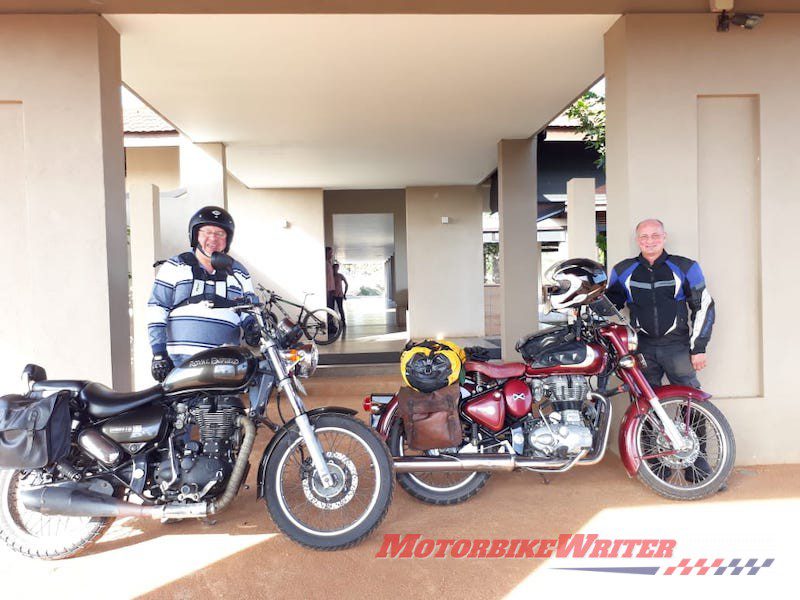
Colombo to Eluvankulam
Normally I leave the busy town of Colombo before 5am but Bob had to travel to meet me and collect his motorcycle. We left at 8.30am and got bogged in the office rush hour which meant it was a slow and tedious affair to get out of Colombo. There was traffic all the way to Negombo (near the international airport) but we kept moving without too much hassle.
We had some refreshments at a roadside restaurant in Negombo and after that, the road narrowed, the traffic was almost continuous, and it was a bother until we passed Chilaw. From there onward it was a pleasure riding on a smooth road with not much traffic with some large lagoons on the left.

We were stopped by police before Puttalam but they just wanted to check our drivers’ licences, motorcycle registration and insurance papers. This is a common occurrence and nothing to be worried about. As a foreigner they won’t hassle you, but I always recommend you have an International Driver’s Licence. Please don’t show your original drivers’ licence! We spoke to them in English (although we can speak the Sinhalese language) and they became our friends.

The Royal Enfield bikes rumbled along the road, their distinctive beat echoing around the countryside. People on the road heard this “Doof” “Doof” sound and looked at us and our bikes along the way. We passed Puttalam, where much of the salt in Sri Lanka is made, and then travelled along a wonderful motorcycling road to a small hamlet called Eluvankulam, which is 28 kilometres north of Puttalam. This is only a few kilometres south of Wilpattu, the largest and oldest national park in Sri Lanka.
We arrived at “The Backwaters” resort which is managed by Tarique Omar, a school friend and motorcycle rider. Tarique was in Colombo but we were greeted by his second-in-command, Rizvi, who also loves riding motorcycles. The resort was so pleasant that we decided to stay an extra day because I wanted to take a boat trip to visit an ancient Baobab tree planted by Arab traders in ancient times as well as visit some historic ruins within Wilpattu National Park. While on the safari we saw elephants, deer, birds, wild boar and crocodiles but not the elusive leopard and bear. To our dismay, a family that was staying at The Backwaters showed us photographs they had taken of a leopard only a few minutes after we had passed that very spot.

Eluvankulam to Mannar
There are two routes to travel from Puttalam to Mannar. The most direct is through Wilpattu National Park, which is a dirt road that is passable during the dry season. I have been on that road on a motorcycle and I was pretty scared as the jungle closes to the verges of the road in many places and there could be wildlife just next to you. I didn’t want to end up as leopard shit or trampled by an elephant.
The other road skirts Wilpattu National Park to the east and that is what we took. We travelled along some small roads through villages and joined the main road to the ancient city of Anuradhapura. A little further on is the large Thabbowa Wewa (lake) which was partially dry. I have seen this beautiful lake when it is full with water as the road passes through the southern end of it and it’s fascinating to see water on either side with lots of birds. The road then passes through jungle which is an elephant corridor and it’s not advisable to ride or drive along that section in the night. You certainly don’t want to meet a wild elephant while on a motorcycle!
We didn’t have to travel all the way to Anuradhapura, instead turning north to Tantirimale, an ancient Buddhist monastery which has beautiful old rock carvings of a reclining Buddha and other images. It’s best to visit this historic site in the morning because it is built on a large rock outcrop and can get extremely hot from around 10:30am.
The road to Tantirimale is also through small villages and is a motorcyclist’s dream. My plan was to stop and take a look at the monastery but a high-ranking politician had arrived for a function and we weren’t allowed to park our motorcycles near the temple. The policemen were extremely polite and were interested in our motorcycles but we only bought some bottles of water and proceeded north along a somewhat bumpy road until we came to the Mannar road.
We turned west and rumbled along the flat and parched countryside which hadn’t seen rain for many months. Bob was setting a hectic pace, well over the maximum speed limit in Sri Lanka, which is just 70 km/h. One of my reasons for travelling along this road was to see an ancient reservoir called Yodha Wewa (Giant’s Tank). Nobody yet knows when this engineering marvel was constructed and the British engineers considered it a failed construction works because they couldn’t understand how the whole system worked. There is absolutely no signage or information about this reservoir along the road, except for a huge bund that accompanies you on the right when travelling towards Mannar. I stopped the motorcycle, climbed the bund and was amazed at the expanse that I could see. There wasn’t much water but I couldn’t even imagine what it would look like when the rains came.
Apparently, this reservoir gets its water from a river far away and the gradient of the slope is so small that it’s almost impossible to recreate in modern times. And the reservoir feeds a number of lakes (called “tanks”) that have been silted up over the 2000 plus years when these civil engineering works were first constructed. Even today, the full extent of the irrigation scheme is yet to be understood which shows how advanced that ancient civilisation was when Europeans at that time were living a subsistence life.
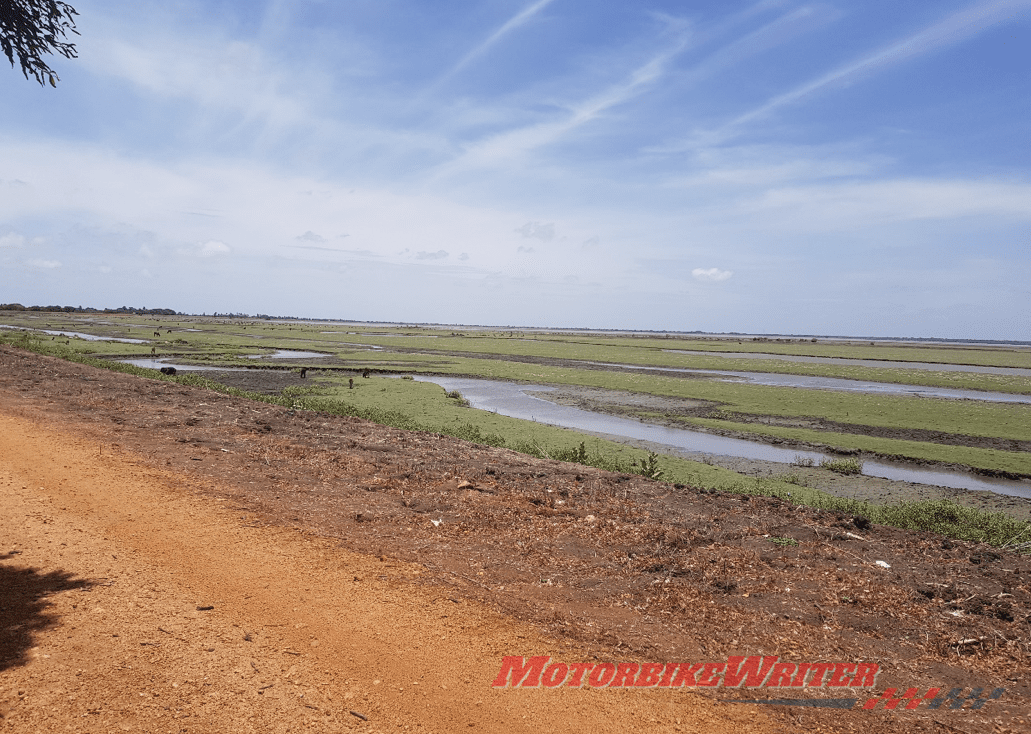
About 25km later we reached the causeway that connects the island of Mannar to the mainland. It’s an amazing feeling riding along a road about a metre above the waters of the Gulf of Mannar on one side and the waters of the Palk Strait on the other. In ancient times, this was the main passage for vessels sailing from the Indian Ocean to the Bay of Bengal but over the years the waters have got very shallow due to silting and now only small fishing boats can use the passageway.
A bridge takes you over the last part of the causeway and you will see the Mannar Fort, first built by the Portuguese, expanded by the Dutch and then taken over by the British. The purpose of the fort was to control and levy taxes on shipping though the passage but sadly the fort is now abandoned and not maintained. If you are interested in history, the fort has the remains of an old Dutch church and a number of engraved tombstones on the floor.
The next thing you will notice in Mannar are the donkeys roaming all over. They were brought by Arab traders in ancient times and used to transport goods inland and bring back items that they took overseas. When modern transportation was introduced, the donkeys were let loose and now roam wild.
Our journey continued along a bumpy and narrow road to the Palmyrah House which is located in the middle of the island. It’s a hotel that is environmentally friendly and has ponds that attract birds and wildlife, especially during the drought that had been experienced for many months. The General Manager, Udaya Karunaratne, is a school friend and has ridden his Honda Africa Twin to all parts of the island. He is more than happy to welcome motorcyclists and offer advice and suggestions.
We consumed chilled beers and relaxed in the quiet and peaceful hotel. The weather was warm and humid, but we had been buffeted for many kilometres by the “trade winds” that blow inland at this time of the year. It was so relaxing that I didn’t want to travel the 28 kilometres to the end of the island to see “Adam’s Bridge” (also called “Rama’s Bridge”) which is a row of islands and sand bars that partially connect Sri Lanka to India. The owners of the Palmyrah House have a property adjoining the first of these islands called “Vayu Resorts” which is a popular kitesurfing place at this time of the year.
There are a couple of stories as to how these names came about. The ancient “Ramayana” epic states that a king in India called Rama, enlisted the help of ape people (“Hanuman”) to build the bridge so he could cross with his army to Lanka to free his wife who had been kidnapped by a king called Ravana. The second story is that Adam and Eve used this bridge to cross from India to Sri Lanka after they were driven out of the Garden of Eden. In fact, at the tip of Mannar island are two extremely long graves, measuring 40 feet and 38 feet, that are supposed to be the tombs of Adam and Eve respectively. I haven’t seen them, but I definitely will on my next visit.
Mannar to Jaffnar and back
My plan was to ride to Jaffna and stay the night there which would have given us time to visit some of the historic sites as well as ride to some of the nearby islands. Bob, however, was very happy staying at the Palmyrah House in Mannar and wanted to ride to Jaffna and back the same day. The distance to Jaffna was just 130 kilometres so that wasn’t be a problem as there isn’t much traffic on that road.
We set off at 8:30am and once again Bob set a cracking pace as we zoomed along the smooth road at around 100 km/h, well over the speed limit. Fortunately we weren’t stopped by the police and we reached Pooneryn in about an hour and stopped to buy some iced drinks and get the circulation going again in our bums. The landscape is flat, the road is generally straight and there isn’t anything interesting to see, but it’s a good ride.

A short time later we were crossing the long causeway which connects the Jaffna peninsula to the mainland. This was built only after the civil war ended in 2009 and is a lovely stretch to ride with water on either side. However, a blustery crosswind was moving my bike around although Bob’s weight had his bike planted firmly on the tarmac. We were soon in Jaffna town where the traffic was chaotic and we stopped in front of the massive Jaffna Fort. This huge and ancient structure was damaged during the civil war, with the beautiful Dutch Church completely destroyed by the terrorists.
We didn’t go inside the fort, but instead I wanted to look at a couple of historic ruins. Our bikes rumbled to life and soon we were completely lost in the maze of streets that meander throughout Jaffna town and the surrounding area. I eventually gave up in disgust and we found our way back to the main road. I asked Bob whether he wanted anything to eat, but he said we should travel back to Mannar and have lunch at the Palmyrah House.
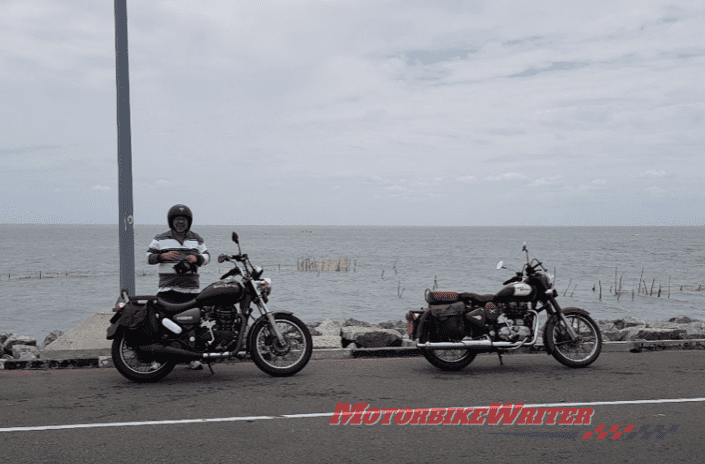
The time was around 11:45am when we left Jaffna and we were soon travelling fast in a southerly direction with the crosswind knocking my bike about. All good things have to end as a policeman jumped onto the road and signalled for Bob to stop. He had a radar gun and it showed that Bob was travelling around 80 km/h in a 50 km/h zone! The policemen were very polite and decent when they saw our white faces and we spoke to them in English. To add to the drama, Bob only had a photocopy of his Australian drivers’ licence which wasn’t adequate.
However, the policemen soon became our friends and after a surreptitious exchange of a small amount of money, we got back on our bikes and travelled the remaining 20 kilometres to Mannar and were back at the Palmyrah House where Udaya Karunaratne was so surprised to see us back that early that he asked us whether we had actually travelled to Jaffna.
My bum was aching and I walked around for some time, downing chilled beers while the kitchen rustled up some sandwiches and French fries for us. The time was around 1.15pm and Bob decided to relax in the swimming pool after lunch.
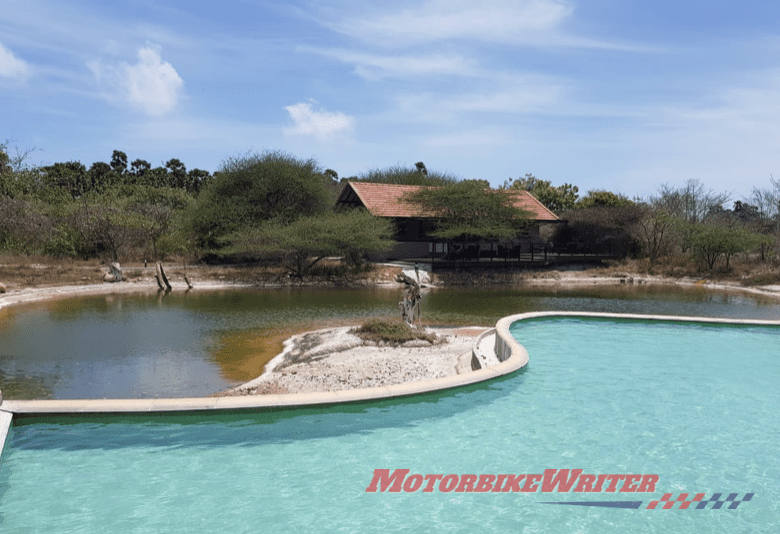
The dinner was delicious, especially the fried crab and we went to bed fairly early. It had been a great day riding and then relaxing in the hotel.
Mannar to Eluvankulam
Bob and I were sad to leave Palmyrah House because we had really enjoyed our stay and especially the friendly and helpful staff who had looked after us so well. They were almost all from the island of Mannar who have had the chance to learn new skills and the opportunity of having a career in hospitality. This was our reason for “Riding for Sri Lanka.”
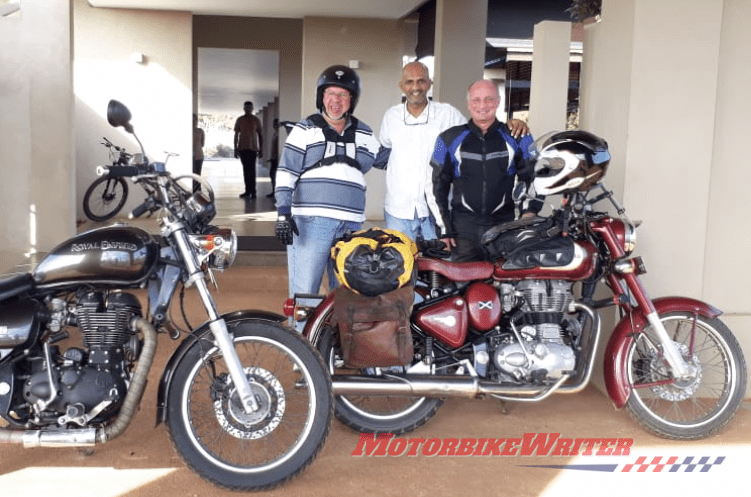
Udaya wished us goodbye as the Royal Enfield bikes rumbled away and Bob stuck to the speed limit. It was frustrating travelling along those empty roads at 70 km/h but I did get a chance to survey the countryside much better. We were soon back at Tantirimale where we parked our motorcycles in front of the historic monastery and drank some chilled drinks.
A local lady had brought some of the most beautiful Lotus flowers to sell to visitors to the temple and the deep purple hues of those flowers was really astounding. Sri Lankan people in the villages and small towns are the friendliest on this earth and will go out of their way to help you if needed. They are generally shy and reserved, but all you need is to strike up a conversation, even if they don’t know English, and they will become your friends. And it is very rare that they will try to extract money from you.
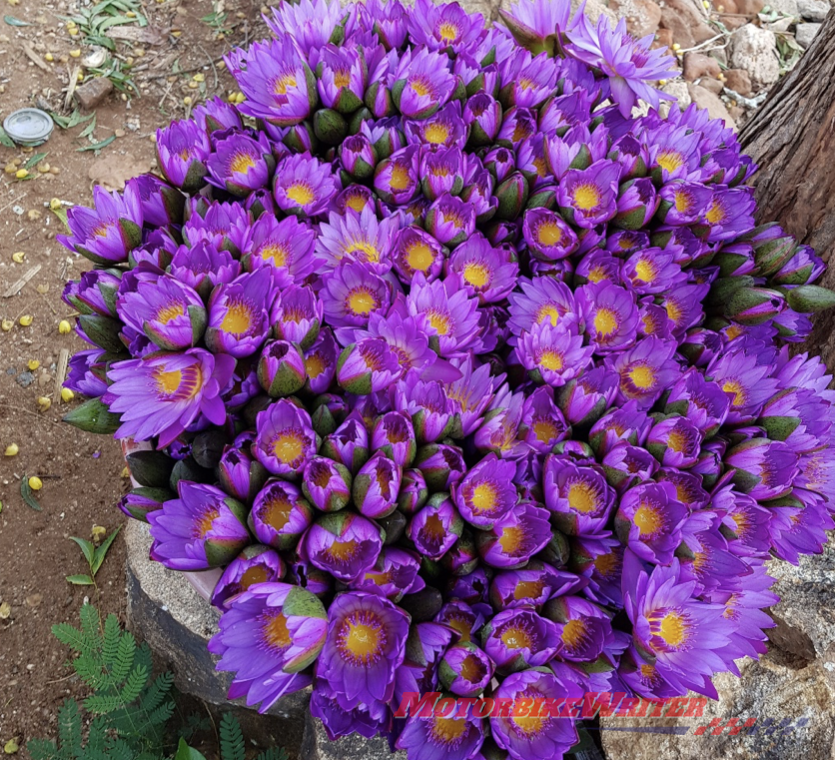
Our bikes rumbled back to life and we enjoyed our ride back to the main road to Puttalam. From there we maintained the speed limit because there were many police, but nobody bothered us.
We then turned off to Thabbowa and enjoyed a peaceful ride through remote villages until we arrived at the road to Eluvankulam. The time was 11:00am and I called Tarique Omar to have the beers chilled and lunch prepared as we would be at The Backwaters in a few minutes. The staff at the resort are lovely people from the local village and go out of their way to make your stay something to remember. And the food they cook is really great.

Tarique Omar was at The Backwaters when we arrived and we were greeted by Rizvi with chilled cans of beer which lubricated our parched throats. Tarique joined us with some beers, even though he hadn’t ridden with us. He was supposed to have joined us for the ride to Mannar on his Honda CB400 but had to go to Colombo for a family function and was jealous of our escapades.

The Backwaters is a place where you can chill out and that’s exactly what we did. In the evening we walked down to the placid waters of the Uppu Aru and watched the sunset. The property has a resident wild elephant who roams around when everyone is asleep but hasn’t harmed anyone or damaged any property. It’s unbelievable how such a large animal can walk around so silently.
Eluvankulam to Colombo
The ride back to Colombo meant battling with traffic and I planned to reach the city after the morning rush hour but before the schools closed. That meant getting home between 11:00am and noon. The journey is approximately 3.5 hours by car, but motorcyclists aren’t permitted on the motorway that runs from the airport to the outskirts of the city.
We left The Backwaters at 8.30am and had a peaceful ride until we approached Chilaw when the traffic increased considerably. Like a pair of gladiators, we battled the tintops. The road only has one lane in each direction which makes overtaking difficult.
We didn’t stop until we reached Negombo where the road widens into dual-lanes in each direction. The traffic now moved more smoothly but as we approached Colombo we ran into heavy traffic and ultimately a traffic jam. However, after some horrible minutes, we turned off onto backroads and arrived at my friend’s house around 12:15pm which wasn’t a bad run. We pulled off our riding gear and immediately attacked the beers.
Bob has sunburn on his face as he was wearing an open-face helmet without a visor
It had been a wonderful ride up the west coast of the island over six days and the weather gods had been kind to us as we only had about two minutes of rain. While we were enjoying ourselves, Colombo had been experiencing a lot of rain. Such is the nature of a tropical island that experiences monsoonal conditions and it’s always good to carry wet weather gear regardless of what time of the year you travel around the island.
We were determined to prove that it’s safe to travel in Sri Lanka and both Bob and I never felt unsafe at any time during our trip. And there’s no better way to explore the island than on a Royal Enfield motorbike which has a remarkable presence on the roads of Sri Lanka as it’s not a common bike and its distinctive sound always attracts attention. You certainly make friends on a Royal Enfield.
If you are interested in riding a motorcycle in Sri Lanka, please contact Rohan by email at Rohan.Sourjah@gmail.com or on 0438264632.
If you want to see photos of this ride, and other previous rides, please visit his Facebook page.


